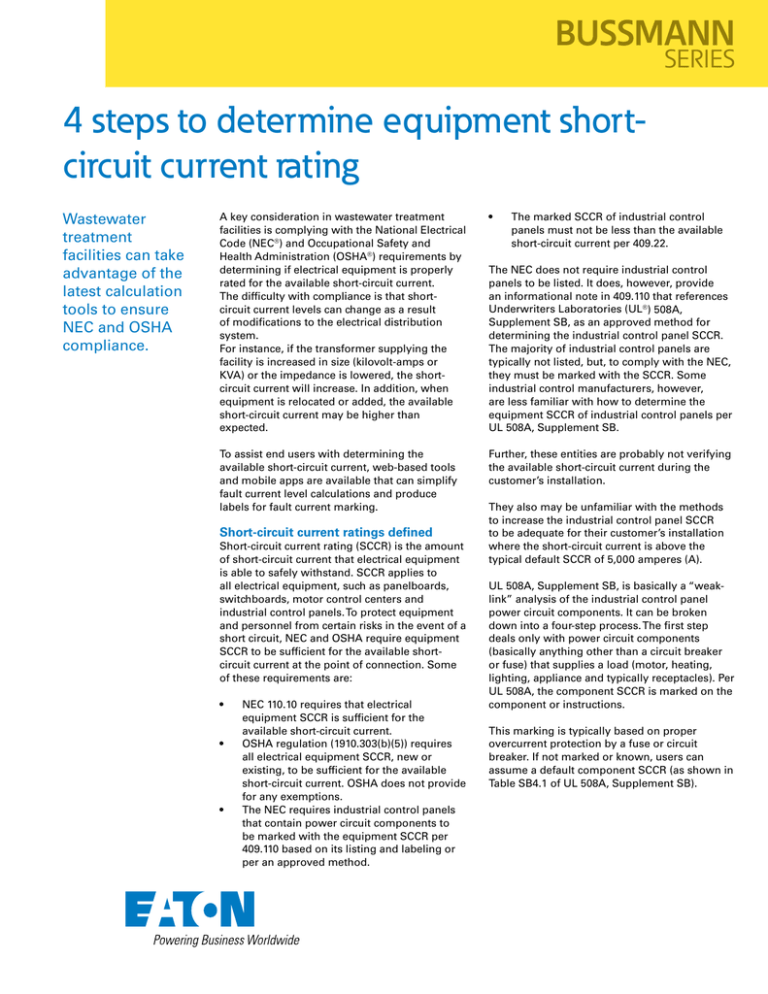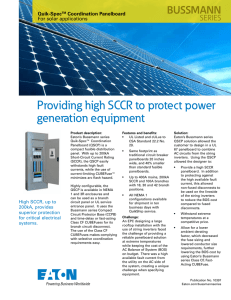
BUSSMANN
SERIES
4 steps to determine equipment shortcircuit current rating
Wastewater
treatment
facilities can take
advantage of the
latest calculation
tools to ensure
NEC and OSHA
compliance.
A key consideration in wastewater treatment
facilities is complying with the National Electrical
Code (NEC®) and Occupational Safety and
Health Administration (OSHA®) requirements by
determining if electrical equipment is properly
rated for the available short-circuit current.
The difficulty with compliance is that shortcircuit current levels can change as a result
of modifications to the electrical distribution
system.
For instance, if the transformer supplying the
facility is increased in size (kilovolt-amps or
KVA) or the impedance is lowered, the shortcircuit current will increase. In addition, when
equipment is relocated or added, the available
short-circuit current may be higher than
expected.
To assist end users with determining the
available short-circuit current, web-based tools
and mobile apps are available that can simplify
fault current level calculations and produce
labels for fault current marking.
Short-circuit current ratings defined
Short-circuit current rating (SCCR) is the amount
of short-circuit current that electrical equipment
is able to safely withstand. SCCR applies to
all electrical equipment, such as panelboards,
switchboards, motor control centers and
industrial control panels. To protect equipment
and personnel from certain risks in the event of a
short circuit, NEC and OSHA require equipment
SCCR to be sufficient for the available shortcircuit current at the point of connection. Some
of these requirements are:
•
•
•
NEC 110.10 requires that electrical
equipment SCCR is sufficient for the
available short-circuit current.
OSHA regulation (1910.303(b)(5)) requires
all electrical equipment SCCR, new or
existing, to be sufficient for the available
short-circuit current. OSHA does not provide
for any exemptions.
The NEC requires industrial control panels
that contain power circuit components to
be marked with the equipment SCCR per
409.110 based on its listing and labeling or
per an approved method.
•
The marked SCCR of industrial control
panels must not be less than the available
short-circuit current per 409.22.
The NEC does not require industrial control
panels to be listed. It does, however, provide
an informational note in 409.110 that references
Underwriters Laboratories (UL®) 508A,
Supplement SB, as an approved method for
determining the industrial control panel SCCR.
The majority of industrial control panels are
typically not listed, but, to comply with the NEC,
they must be marked with the SCCR. Some
industrial control manufacturers, however,
are less familiar with how to determine the
equipment SCCR of industrial control panels per
UL 508A, Supplement SB.
Further, these entities are probably not verifying
the available short-circuit current during the
customer’s installation.
They also may be unfamiliar with the methods
to increase the industrial control panel SCCR
to be adequate for their customer’s installation
where the short-circuit current is above the
typical default SCCR of 5,000 amperes (A).
UL 508A, Supplement SB, is basically a “weaklink” analysis of the industrial control panel
power circuit components. It can be broken
down into a four-step process. The first step
deals only with power circuit components
(basically anything other than a circuit breaker
or fuse) that supplies a load (motor, heating,
lighting, appliance and typically receptacles). Per
UL 508A, the component SCCR is marked on the
component or instructions.
This marking is typically based on proper
overcurrent protection by a fuse or circuit
breaker. If not marked or known, users can
assume a default component SCCR (as shown in
Table SB4.1 of UL 508A, Supplement SB).
Four steps to determine equipment SCCR
1. Determine high-fault rating for power circuit components
Most power circuit components can be tested for an optional
high-fault rating that may require a specific circuit breaker or fuse.
These optional high-fault ratings can be found on UL’s website for
combination motor controllers. Other types of component SCCRs,
including those of adjustable speed drives, can be more difficult
to find. Adjustable speed drives as listed to UL 508C/UL 61800-51, may require a special type of overcurrent protection device—in
some cases, a semiconductor fuse—to achieve a high SCCR. This
required overcurrent protection device often is not marked on the
adjustable speed drive but instead in the equipment’s installation
and operation manual. Where overcurrent devices are used with
slash voltage ratings, such as 480/277, or when combination motor
controllers that result in slash voltage rating are used, the industrial
control panel must be marked with this slash rating as well.
2. Verify whether a current-limiting device is ahead of the branch
circuit components (in the feeder circuit).
The branch circuit components would be the components closest
to the load, but on the load side of the branch circuit fuse or circuit
breaker. The current limiting device in the feeder would then be
upstream of the branch circuit fuse or circuit breaker.
• The current-limiting device could be a transformer, currentlimiting circuit breaker or current-limiting fuse. If the device is a
transformer, the process is relatively simple:
• Find the let-through of the transformer (Table SB4.3 or SB4.4)
if the let-through is less than the branch circuit component and
overcurrent device ratings, then apply the primary overcurrent
device interrupting rating to the entire branch circuit.
• If the device is a current-limiting fuse or circuit breaker, the
let-through is determined by Tables SB4.2 for various classes
of current-limiting fuses or by published manufacturer data for
marked current-limiting circuit breakers.
• If the let-through of the current-limiting fuse or circuit
breaker at a given fault current is less than the branch circuit
components, raise the component SCCR to the fault current
that was referenced.
Bussmann series OSCARTM Compliance
Software calculates and documents
assembly SCCR for a control panel.
3. Establish the interrupting ratings for all the fuses and circuit
breakers in the feeder and branch circuits.
This includes the fuses and circuit breakers that supply control
transformers and power supplies. Fuses or circuit breakers
that supply control circuits on the load side of a motor branch
circuit overcurrent may be branch circuit overcurrent devices or
supplemental overcurrent protection devices, but the interrupting
ratings of these overcurrent devices affect the assembly SCCR.
4. Find the lowest component or overcurrent device rating in the
assembly based on Steps 1, 2 and 3.
This becomes the industrial control panel SCCR. The UL 508A,
Supplement SB, requirements and component short-circuit current
ratings can be difficult to understand and apply. For this reason,
most industrial control panels are marked with the typical default
rating of 5,000 A. This can create problems with NEC and OSHA
compliance when the industrial control panel SCCR is not sufficient
for the available short-circuit current.
To ensure compliance, the design engineers for wastewater
treatment facilities must determine the available short-circuit
current where the industrial control panels should be installed. They
should also consider that these industrial control panels may be
relocated where the available short-circuit current is higher.
Often, a minimum industrial control panel SCCR, such as 50,000 A,
is determined to allow for flexible application of industrial control
panels in a given facility regardless of location.
Complying with the latest national and local codes and standards
is vital for supporting personnel safety and electrical system
reliability. Wastewater treatment facilities should consider tapping
the latest tools to help meet these requirements and simplify
compliance.
SCCR Protection Suite helps equipment
designers identify components with the
SCCR required.
Eaton
1000 Eaton Boulevard
Cleveland, OH 44122
United States
Eaton.com
Bussmann Division
114 Old State Road
Ellisville, MO 63021
United States
Eaton.com/bussmannseries
© 2016 Eaton
All Rights Reserved
Printed in USA
Publication No. 10538
April 2016
Eaton, Bussmann and OSCAR are valuable
trademarks of Eaton in the US and other
countries. You are not permitted to use the
Eaton trademarks without prior written
consent of Eaton.
NEC is a registered trademark of the
National Fire Protection Association, Inc.
OSHA is a trademark of the United States
Department of Labor.
UL is a registered trademark of the
Underwriters Laboratories, Inc.
Bussmann series FC2 Available Fault
Current Calculator easily calculates
available fault current anytime, anywhere.
For Eaton’s Bussmann series
product information,
call 1-855-287-7626 or visit:
Eaton.com/bussmannseries
Follow us on social media to get the
latest product and support information.












